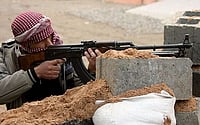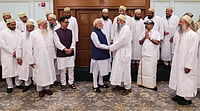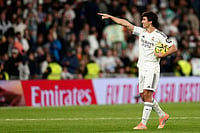Dark clouds enveloped Mumbai in the last week of June 2022, but the rains did not seem to be in a hurry that year.
Who was in a political hurry around the time was 58-year-old Eknath Shinde, a top Shiv Sena leader and an Urban Affairs Minister in the state’s Maha Vikas Aghadi (MVA) government. Shinde broke the backs of the MVA and the Shiv Sena to join hands with the Bharatiya Janata Party to install a new government in Maharashtra, with the help of 40 Sena rebels.
Amid the turmoil on the ground in the western Indian state, the heavens finally opened up. On the evening of June 29, as heavy rains lashed across the city, a calm and smiling Uddhav appeared live on Facebook to put the political uncertainty in Maharashtra in perspective.
“Democracy must be upheld. We will do it and so must all. Let them enjoy the deed of pulling down Sena supremo’s son from the post of CM,” Uddhav said, after rendering his resignation.
Thackeray’s composure was acknowledged widely across the internet, with several posts expressing sadness at his departure from the government’s helm. The overwhelming support of Bollywood celebrities, socialites, social activists, writers and even astute political observers in Maharashtra for Uddhav was unusual, especially coming from the liberal quarter, whose proponents once had to face the aggressive wrath of the Sena, under its original patriarch, the late Bal Thackeray. Thackeray was Uddhav’s father, but he was also a picture in contrast.
“If even a single MLA from Shiv Sena defects, then kick him in the middle of the road, without worrying about the law….these b****as should get such punishment only. There is no need for a warning, this is the question of our survival,” Bal Thackeray had thundered at a public rally in the mid-1990s, just before the party assumed power in Maharashtra, in alliance with the Bharatiya Janata Party as its junior partner.
Uddhav, by his own admission, doesn’t seek vengeance. His Sena differs not only in leadership style from Bal Thackeray’s era but also in fundamental political ideology and discourse.
Chauvinism & Hindutva
A towering figure, Bal Thackeray, a pipe-smoking cartoonist with thick-rimmed glasses, was distinct in appearance. As editor of Marmik, his Marathi periodical, his radical speeches and cartoons targeted South Indian migrants, advocated economic boycotts and highlighted injustices against Marathi youths in job allocation, endorsing aggressive tactics to uphold Marathi pride amid linguistic politics.
Thackeray, witnessing Marathi people’s alienation in Maharashtra, a state born from linguistic struggles in 1960, advocated for the “sons of the soil” agenda. He pushed for 80 per cent job and housing reservations for Maharashtrians, asserting that even the city’s “goondas and prostitutes” should be Maharashtrian.
On June 19, 1966, Bal Thackeray founded Shiv Sena, adopting a roaring tiger as its emblem. Targeting South Indian migrants, Thackeray’s Shiv Sainiks attacked Udupi restaurants for currency and visibility. But despite significant victories in Thane and Bombay’s civic elections, the party struggled against the dominance of the Congress party.
As Maharashtra gears up for another election in 2024, the question looms: Will Uddhav’s UBT faction endure politically? And what will be the fate of Shinde’s Sena?
As Bal Thackeray continued to target the Congress, socialists and communists for political sustenance, the Shiv Sena expanded. His raw, aggressive style, filled with expletives, tirades and taunts, resonated with the audience, drawing enthusiastic responses despite its venomous nature.
Prakash Akolkar, a senior journalist and author of Jai Maharashtra, noted Shiv Sena’s varied political alliances and ideological shifts. In 1975, despite the ban on Marmik by Indira Gandhi, Bal Thackeray supported the Emergency and even campaigned for Congress leader Murli Deora in mayoral elections. “Sena has made alliances with Congress, BJP and the NCP. CPI (M) and the Samajwadi Party are the only two regional parties with whom he (Bal Thackeray) could not get along,” Akolkar said.
Men and women of all ages flocked to Thackeray’s rallies. In 1985, Shiv Sena tasted political success, winning 75 seats in the prestigious Bombay Municipal Corporation (BMC) polls. Simultaneously, Thackeray’s image underwent a shift; he traded safari suits for white kurta-pyjamas, adorned with a shawl and rudraksha rosary, visibly embodying Hindutva. His speeches embraced hardline Hindutva, urging votes for candidate Ramesh Prabhoo in the 1989 Ville Parle bypoll, warning of religious conflict if Hindus didn’t support him.
Prabhoo’s win highlighted Shiv Sena’s recognition of Hindutva’s electoral influence. Extending this success to Aurangabad’s civic polls, Sena merged ethnic chauvinism with Hindutva, becoming the first regional party to do so. Aligned with the Ram Janmabhoomi movement, Hindutva became central to the Sena’s ethos, leading to alliances with BJP for Lok Sabha and Maharashtra assembly elections.
Bal Thackeray was also barred by the Election Commission of India (ECI) for breaching the Representation of Peoples Act by invoking religion to urge Hindu voters to support Hindu candidates during the Vile Parle bypoll. The Supreme Court affirmed the Bombay High Court’s decision, disqualifying Thackeray and Prabhoo from voting and contesting elections for six years starting from 1995.
Bal Thackeray, however, remained indifferent to his disenfranchisement and legal battles over inflammatory speeches. His power lay in the Sena’s towering influence and the fact that his sainiks could shut down Bombay at his command and will. Following the Babri mosque’s demolition, he congratulated the kar sevaks and brazenly claimed credit for the destruction.
Bal Thackeray had now become Balasaheb Thackeray and was bestowed with the title of ‘Hindu Hriday Samrat’ signifying his influence as the supremo of Hindu hearts.
Sena under Bal Thackeray
In 1995, Sena-BJP finally broke the Congress dominance, winning the state polls and installing its MLA Manohar Joshi, as chief minister of Maharashtra. They also regained control of the BMC after previously losing it to Congress, maintaining authority over Mumbai’s municipal corporation since 1997. The party formally renamed Bombay to Mumbai, honouring the city’s patron deity, Mumba Devi.
Shiv Sena wielded influence in Mumbai and Maharashtra, focusing on Marathi interests, limiting its reach beyond the state. However, Bal Thackeray’s legacy extends nationwide. Even today, his framed photos adorn the shops of Kashmiri Pandits in Jammu, for supporting their cause against Pakistan-sponsored militants, and advocating justice for them.
Bal Thackeray hesitated to assume direct political power, asserting, “anyone can be the chief minister, but the remote control of the state is with me.” In assuming charge as chief minister in 2019, Uddhav, in a way, broke the Thackeray tradition, becoming the first family member to hold the position. Assuming leadership of the Shiv Sena in 2003 and fully taking over charge after his father’s passing in 2012, Uddhav has continued to uphold Marathi and Hindutva ideals, but with a softer, hands-on and tolerant approach.
Party workers note stark differences in leadership styles between the Thackerays, shaped by distinct political eras. Bal Thackeray’s charismatic, single-handed party leadership relied on provocative, slang-laden Marathi speeches, often assassinating opposition characters. He championed press freedom but clashed with journalists. In contrast, Uddhav is a mild-mannered administrator diverging from his father’s abrasive tactics and embracing a more tolerant demeanour.
Decades before Rihanna’s appearance at Jamnagar, Bal Thackeray was responsible for inviting Michael Jackson to perform in India in 1996. Shiv Udyog Sena, led by nephew Raj Thackeray, collaborated with Wizcraft to organise Jackson’s performance in the city. Journalist Vaibhav Purandare noted the event’s aim to generate local employment in his book Bal Thackeray and the Rise of the Shiv Sena. In a cheeky comment, Bal Thackeray mentioned Jackson using his toilet and joked about his appearance resembling “somewhere in between” a man and a woman.
The party made headlines with its religious and nationalist agenda, targeting Muslims and Pakistan. Shiv Sena supporters vandalised cricket pitches in Mumbai’s Wankhede Stadium and Ferozshah Kotla in Delhi before an India-Pakistan match. Post-Babri demolition and Kargil war, its anti-Muslim campaigns turned violent.
Violence and ruckus marked Sena’s protests against the movie Fire, Valentine’s Day and attacks on Salman Rushdie, M F Hussain and journalists critical of its politics.

Sena under Uddhav
Uddhav has steered Sena away from his father’s era, focusing on organisational structure over personality cult. Violence has diminished, but not vanished entirely. In 2015, Shiv Sena members attacked Sudheendra Kulkarni, former aide to ex-Prime Minister late Atal Bihari Vajpayee, for hosting a Pakistani politician. The party’s identity still revolves around aggression, according to the Sena’s Uddhav Bal Thackeray faction spokesperson, Harshal Pradhan.
During the Maharashtra assembly election campaign in October 2014, Uddhav criticised Prime Minister Narendra Modi’s cabinet, likening it to the army of Mughal general Afzal Khan, who sought to diminish Shivaji’s dominion in the 17th century.
Uddhav accused Modi’s party of trying to “break the state into pieces” under the guise of progress and development. The ‘Afzal Khan’ remark was not taken lightly by Modi and his second-in-command, Amit Shah. Political observers view this as a key factor fuelling animosity between Shiv Sena and the BJP. Uddhav’s prediction would materialise in Shinde’s June 2022 rebellion, unbeknownst to him at the time.
Despite the BJP’s success in various other states, it has so far failed to secure a simple majority in Maharashtra. Uddhav supported the BJP, but felt sidelined by Chief Minister Devendra Fadnavis’ administration. In 2017, Shiv Sena nearly lost the BMC elections, with both parties running neck and neck. Ultimately, Shiv Sena secured 84 seats, narrowly surpassing the BJP’s 82 in a tense finish.
In 2019, as the Modi wave gripped the country, Shiv Sena again went ahead with their alliance with the BJP for the Lok Sabha and state assembly elections. “While the two parties had an understanding on seat sharing, Sena observed that the BJP surreptitiously fielded many independent candidates against Sena candidates. There was a clear attempt to sabotage its assured victory,” says Sudhir Suryawanshi, journalist and author of Checkmate: How the BJP won and lost Maharashtra.
Shiv Sena won 18 seats in Lok Sabha and 124 seats in the assembly elections, while the BJP won 23 seats and 152 seats, respectively. The BJP and Sena clashed over agreement on the CM’s post. “All these years, the BJP was a junior party to the Shiv Sena which had more power and influence in the state. But after Modi came to power, the BJP’s aspirations became bigger and it was no longer ready to play second fiddle to the Sena,” says Sanjay Patil, a research scholar on politics and elections at the Mumbai University. “The only way ahead for it was to finish the influence of Shiv Sena and the NCP, the two main regional parties of Maharashtra were its main hurdles.”
Fadnavis broke the BJP alliance with Sena, claiming the CM post by poaching Ajit Pawar and NCP MLAs. Uddhav outmanoeuvred them, forming a coalition with the Congress-NCP and proving a majority in the assembly. His alliance shift, viewed by many as betrayal, marked a departure from the BJP to align with ideologically opposing parties.
Following the coalition’s formation, the BJP launched a fierce campaign against Uddhav, his family and the Shiv Sena to destabilise the Maharashtra Vikas Aghadi government. Amid the COVID-19 lockdown in March 2020, Uddhav’s poised leadership shone as he reassured citizens in live addresses, offering a soothing presence during the crisis.
Amid nationwide CAA-NRC protests and Delhi riots, the Tablighi Jamaat faced blame for spreading COVID-19, labelled “corona jihad” by Hindutva and BJP proponents. While several states witnessed subsequent anti-Muslim violence, Maharashtra remained peaceful and unaffected by communal vitriol, defying the turbulent communal atmosphere.
Uddhav made a special note of this incident during his resignation speech as he thanked the citizenry for keeping Maharashtra safe and secure during this tumultuous time. “Our Muslim brothers also heeded my appeal; I must mention it,” he said. Uddhav’s inclusive governance earned him praise from all sectors. Despite Shiv Sena’s past attacks on Mumbai’s Muslim community, they now support Uddhav, recognising his commitment to public welfare.
Shiv Sena might have fragmented and its politics evolved over the years, but the affinity of Marathi people remains with the Thackeray family.
Future existence
As Maharashtra gears up for another round of elections in 2024, the pivotal question looms: Will Uddhav’s UBT faction endure politically? And what will be the fate of Shinde’s Shiv Sena. What is Shiv Sena without members of the Thackeray family?
Uddhav’s faction has fielded 17 candidates from its party and is determined to retain its hold on Mumbai. Thane, Kalyan and Bhiwandi constituencies fall under the influence of Shinde faction influence and will see a tough fight from the rival Uddhav faction, who wants to see the downfall of the rebel Shinde, starting from his son MP Shrikant Shinde’s defeat from Kalyan constituency.
The ECI has recognised Shinde’s faction as the ‘real’ Shiv Sena, now holding the party’s name and symbol, while Uddhav’s faction bears his name with a burning torch emblem.
Since 2022, defections from Sena to the Shinde Sena-BJP alliance have increased, often following Enforcement Directorate raids. Shinde’s rebellion dealt a severe blow to Uddhav’s faction, although it was not entirely surprising, according to party leaders.
“This was an expected development. We have in fact told all the leaders, those who wish to leave, should do it now,” Pradhan said. High-profile rebellions in the past didn’t alter Shiv Sena’s unique hierarchical structure of Sena shakhas, which remained intact.
In 1991, Chhagan Bhujbal led 18 rebels to join the Congress from the Shiv Sena, while Narayan Rane defected in 1995 to the Congress and later, to the BJP. Uddhav’s cousin Raj Thackeray’s exit in 2005 to form Maharashtra Navnirman Sena deeply hurt sainiks, because they considered him an integral part of the Thackeray clan
According to Patil, Raj Thackeray was considered the heir apparent of Bal Thackeray as he closely resembled his stylish appearance, dashing personality and aggressive speaking style. “When he left the party, there was panic, but look at his party’s performance. He was never able to convert mass support into votes,” the research scholar maintains.
The Raj Thackeray phenomenon has now resurfaced in Maharashtra politics, with the BJP courting him to rally Marathi votes, reportedly offering him an MNS merger with the Shinde Sena leadership. The move will be somewhat of a ‘ghar wapsi’ for Raj.
Patil observed that Shiv Sena’s fate has been written over numerous times in the past, but the party is not dead. “Shiv Sena is different from all other political parties in Maharashtra because it has evolved to be a people’s party. It has an emotional connection with the Thackerays and it is not easy to tear that apart.” For Marathi people, “Shiv Sena is Thackeray and Thackeray’s are Shiv Sena.” The party’s headquarter Sena Bhavan in Dadar, and Thackeray family residence at Matoshree in Kalanagar in Bandra, are not just landmarks, but also political pilgrimage centres.
Aditya Thackeray (33) Uddhav’s son, representing the next generation of the Thackeray family, has also carved a niche as a young politician concerned about the environment and climate change.
Uddhav faces tremendous challenges ahead as he tries to retain the party’s existence and identity in the forthcoming elections, he added. “People see that he is a good administrator, his handling of the Covid-19 crisis made a difference. Despite all the challenges thrown at him, he has stood tall and held the party together. Thackeray’s Sena is not dead.”
MORE FROM THIS ISSUE
Shiv Sena might have fragmented and its politics evolved over the years, but the affinity of Marathi people remains with the Thackeray family. And the party still remains the only voice of the Marathi people, in Mumbai and elsewhere in Maharashtra, with its slogan of Jai Maharashtra.
(This appeared in the print as 'Sena Versus Sena')
































